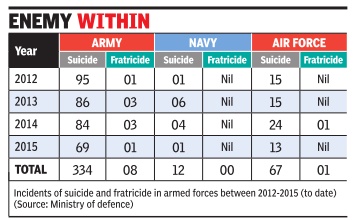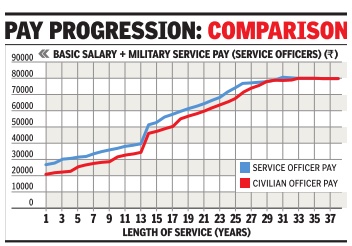Defence services, India: personnel issues
This is a collection of articles archived for the excellence of their content.
|
Contents |
AWOL: SC judgement
The Times of India, October 29, 2015
He who goes AWOL can't be good soldier
A rmy personnel who go on unauthorised leave can never be A good soldiers and there is nothing wrong in discharging such persons from force without issuing show cause notice, the Supreme Court said on Wednesday. A bench of Justices A R Dave and A K Goel upheld the government decision to discharge army man Manoj Deswal who went on leave without taking permission from his commanding officer. The SC said no special notice is required to be given before discharge of a person if he is accused of such indiscipline.
Civilians’ emoluments vis-à-vis defence personnel
2004 onwards: Defence personnel paid considerably higher than civilians
The Times of India, November 23, 2015
Pradeep Thakur
Post-2004, salary gap continues to widen: Panel analysis
Defence personnel get higher pay than civilian counterparts
Officers of the three defence services -Army, IAF and Navy -are paid 29% higher salary compared to their civilian counterparts from the IAS, IPS and other Group A services at the starting level, the seventh pay panel has said. For post-2004 recruits, this pay differential has increased to 43% in favour of defence officers as civil servants who joined thereafter have to contribute towards pension benefits. This gap continues to remain wide at over 20% in favour of defence officers for the first nine years of service and remains uninterruptedly higher for 32 years.
“It does not take into account allowances, which are intended to compensate for specific hardships and risks that (defence) officers face in the discharge of their duties,“ the pay panel noted while doing a comparative analysis of salaries of defence officials with civil servants.
The analysis of pay does not account for other benefits in cash and kind admissible to defence officers such as free rations, tax concession for canteen, travel in railways and by air and free electricity up to 100 units each month.
The comparison was drawn after the three defence services in their joint memorandum urged the panel to maintain their edge in pay over civil servants. In its report submitted to the government on Thursday , the pay panel observed that after the sixth pay commission award, “the pay of defence service officers remains un interruptedly higher for a 32year period. Thereafter, pay of defence and civil service officers are at par“.
“The edge in initial pay for defence service officers, which was 7% post-third CPC, fell marginally to 4% and 3% in the fourth and fifth CPC respectively, has postsixth CPC increased sharply to 29%,“ the report said.
The commission, however, justified the pay edge and said, “Defence forces personnel are trained for war-like situations with highly sophisticated war machinery . They have to keep themselves posted in modern warfare. The military institutions are a key symbol of national pride.“
Further, a study commissioned by the seventh pay panel showed that salaries of defence officers and JCO ORs in India, based on sixth CPC pay scales, compared favourably with that of defence personnel in countries like the US and the UK, where the GDP per capita in purchasing power parity (PPP) terms is significantly higher than that of India -9.4 times in the case of the US and 6.7 times in the case of the UK.
The pay panel clarified that these conclusions were equally applicable to civilian employees who were similarly placed. The Institute of Defence Studies and Analyses carried out the study comparing the salary structure of personnel in the Indian defence forces with that of UK and US on PPP basis.
Veterans to move apex court against OROP notification
The United Front of Ex-servicemen on Sunday declared that it will move the Supreme Court against the central government's “flawed“ notification for One Rank One Pension (OROP). Major General (retd) Satbir Singh, who is advisor to the front, said in Chandigarh that the veterans will move the SC within 10 days through noted lawyer Ram Jethmalani. Singh, who was on his way to Sirhind in Punjab to address an ex-servicemen's rally, reiterated that the veterans' agitation was not for money but for upholding the honour and dignity of the forces. The government's refusal to further discuss the anomalies in the OROP notification had downgraded the honour and dignity of the forces, he alleged. “An initial study of the recommendations of the 7th Pay Commission indicates a further downgrading of that status,“ he said. He said the IAS lobby was working against the interests of the armed forces. TNN
Suicides
597 military personnel have committed suicide in last 5 years, government says
The Times of India Rajat Pandit,TNN | Jul 22, 2014
NEW DELHI: The suicide toll in the highly-disciplined armed forces continues to cross the 100-mark year after year despite all the so-called measures being undertaken by the defence establishment to reduce stress among soldiers.
As many as 597 military personnel committed suicide in 5 years between 2009 and 2013.
Disclosing these figures in the Rajya Sabha on Tuesday, defence minister Arun Jaitely said, "The government has taken various measures to create an appropriate environment for defence personnel, so that they can perform their duty without any mental stress."
These measures, said Jaitley, include improvement in living and working conditions through provision of better infrastructure and facilities, additional family accommodation, liberalized leave policy, a grievance redressal mechanism, psychological counseling and conduct of yoga and meditation as part of a battalion or unit's routine.
But the steps do not seem to be working very well on the ground.
In the Army, by far the largest of the three services, for instance, 116 soldiers committed suicide in 2010, 105 in 2011 and 95 in 2012. Last year, while 86 soldiers committed suicide, the figure for airmen and sailors stood at 15 and 6.
As reported by The Times of India earlier, stress-related cases in the shape of suicides and "fragging" (to kill or wound a fellow-soldier or superior) incidents have shown no signs of abating, and often also lead to disquiet and "clashes between officers and jawans.
Soldiers posted in far-flung areas often undergo tremendous mental stress for not being able to take care of the problems being faced by their families back home, which could range from property disputes and harassment by anti-social elements to financial and marital problems.
While prolonged deployment in counter-insurgency operations in J&K and northeast also takes a toll on the physical endurance and mental health of soldiers, it's compounded by poor salaries, lack of basic amenities, ineffectual leadership and sometimes humiliation at the hands of their officers.
Though former defence minister AK Antony had repeatedly asked state chief ministers and Union Territory lieutenant governors to make their civil district administrations more responsive to grievances of soldiers and their families, the situation remains almost the same.
Suicides
2012-15: 100+ suicides every year
The Times of India, Dec 12 2015

Armed forces still record at least 100 suicides every year
The armed forces continue to lose around 100 personnel to suicides every year despite all the so-called measures being undertaken by the defence establishment to reduce stress among soldiers.
As many as 413 military personnel have committed suicide just since 2012, minister of state for defence Rao Inderjit Singh told Lok Sabha on Friday . The suicide toll in the 1.13-million strong Army was 334 soldiers since 2012, while the number stood at 67 for IAF and 12 for Navy .
“The major reasons for such incidents include occupational hazards, family issuesdomestic problems, perceived grievances, personal issues, mental built, financial problems and inability to withstand stress,“ said Singh.
As reported by TOI earli er, stress-related cases in the shape of suicides and “fragging“ (to kill a fellow-soldier or superior) incidents have shown no signs of abating and often also lead to disquiet and “clashes“ between offi cers and jawans. The Army ncidentally , has seen eight cases of fragging since 2012.
Soldiers posted in far-flung areas often undergo tremen dous mental stress for not be ng able to take care of the problems being faced by their families back home, which could range from property disputes and harassment by antisocial elements to financial and marital problems.
Prolonged deployment in counter-insurgency operations in J&K and northeast also takes a toll on the physical endurance and mental health of soldiers. All this is also compounded by poor salaries, lack of basic amenities, ineffectual leadership and sometimes humiliation at the hands of their officers. Singh said the government has taken several measures to prevent such incidents, with a large number of officers having being trained as counsellors. “The measures include improvement in living and working conditions through provision of better infrastructure and facilities; additional family accommodation; liberalised leave policy; establishing a grievance redressal mechanism; provision of counselling; conduct of yoga, meditation as part of the unit routine etc,“ he said.
But they have not proved very effective in stemming the suicide rate. In the Army , 69 soldiers have already committed suicide this year, while 13 airmen have also taken their lives in the IAF.
“One of the biggest worries for jawans is the hardships their families face back home. With mobile phones, our jawans keep on getting constant updates from their families, which adds to their mental stress and strain,“ said an officer.
